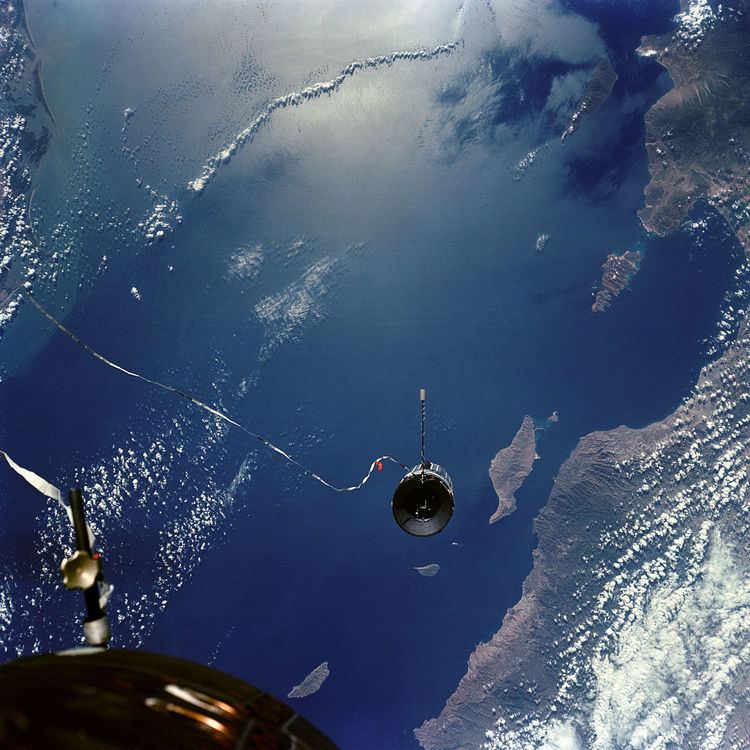SATCAT no. 2415 Spacecraft Gemini SC11 | COSPAR ID 1966-081A Orbits completed 44 | |
 | ||
Mission duration 2 days, 23 hours, 17 minutes, 9 seconds | ||
Gemini 11 (officially Gemini XI)) was the ninth manned spaceflight mission of NASA's Project Gemini, which flew from September 12 to 15, 1966. It was the 17th manned American flight and the 25th spaceflight to that time (includes X-15 flights over 100 kilometers (54 nmi)). Astronauts Charles "Pete" Conrad, Jr. and Richard F. Gordon Jr. performed the first-ever direct-ascent (first orbit) rendezvous with an Agena Target Vehicle, docking with it one hour and thirty-four minutes after launch; used the Agena rocket engine to achieve a world record high-apogee earth orbit; and created a small amount of artificial gravity by spinning the two spacecraft connected by a tether. Gordon also performed two extra-vehicular activities for a total of 2 hours and 41 minutes.
Contents
Support crew
Mission parameters
Highest orbit (followed twice):
Docking
Space walk
Objectives
Flight
The direct-ascent rendezvous and docking with the Agena vehicle was achieved approximately 94 minutes after lift-off, depending on the on-board computer and radar equipment with only minimal assistance from ground support.
Gemini 11 used the rocket on its Agena target vehicle to raise its apogee to 850 miles (1,370 km), the highest Earth orbit ever reached by a manned spacecraft. The perigee was 179 miles (288 km), and maximum velocity (at perigee) was 17,967 miles per hour (28,915 km/h). The apogee record stands as of March 2016, even though men have achieved greater distances from Earth by flying to the Moon in the Apollo program. The maximum operational altitude of the Space Shuttle was lower, at 600 miles (970 km).
The crew docked and undocked four times, and still had sufficient Gemini maneuvering fuel for an unplanned fifth rendezvous. They did not remain in the high orbit, but changed it back to a near-circular one at 184 miles (296 km).
Gordon's first EVA, planned to last for two hours, involved fastening a 100-foot (30 m) tether, stored in the Agena's docking collar, to the Gemini's docking bar for the passive stabilization experiment. Gordon achieved this, but as with previous Gemini EVAs, trying to do work for an extended period proved more fatiguing than in ground simulation, and the EVA had to be terminated after only half an hour.
The passive stabilization experiment proved to be a bit troublesome. Conrad and Gordon separated the craft in a nose-down (i.e., Agena-down) position, but found that the tether would not be kept taut simply by the Earth's gravity gradient, as expected. However, they were able to generate a small amount of artificial gravity, about 0.00015 g, by firing their side thrusters to slowly rotate the combined craft like a slow-motion pair of bolas.
Gordon successfully performed a second EVA standing up with his head and shoulders out of the hatch to photograph the Earth, clouds, and stars. This was not tiring, and lasted more than two hours.
Scientific experiments
The 12 scientific experiments were:
Reentry
The mission ended with the first totally automatic, computer-controlled reentry by the U.S., which brought Gemini 11 down 2.8 miles (4.5 km) from its recovery ship USS Guam, only 1.5 miles (2.4 km) from the planned position.
The Gemini 11 mission was supported by 9,054 United States Department of Defense personnel, 73 aircraft and 13 ships.
Insignia
Since Conrad and Gordon were both members of the US Navy, the embroidered mission patch was designed in Navy colors: blue and gold. Stars are used to mark the major milestones of the mission. The first orbit Agena rendezvous is marked by a small gold star just above the Earth, to the left. The Agena docking is marked by a large star on the left. The star at the top marks the record high apogee reached by Gemini 11. Note that the scale is greatly exaggerated; their maximum altitude of 850 miles (1,370 km) is roughly the distance from St. Louis to Cape Kennedy. Finally, the star on the right marks Dick Gordon's spacewalk. The docking, record apogee and spacewalk are also shown on the patch by the Agena, orbital apogee path and spacewalking astronaut.
Spacecraft location
The spacecraft is on display at the California Science Center in Los Angeles, California.
